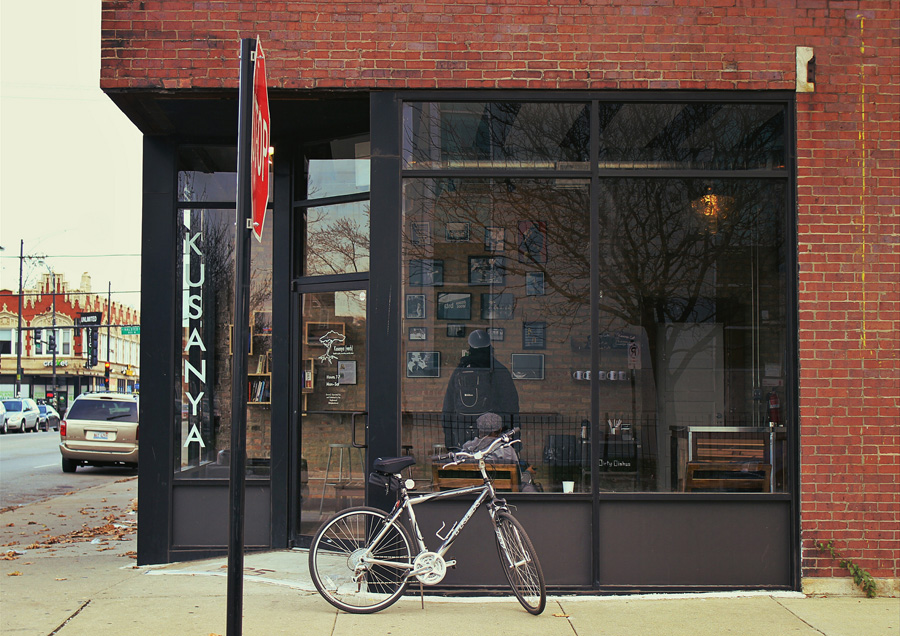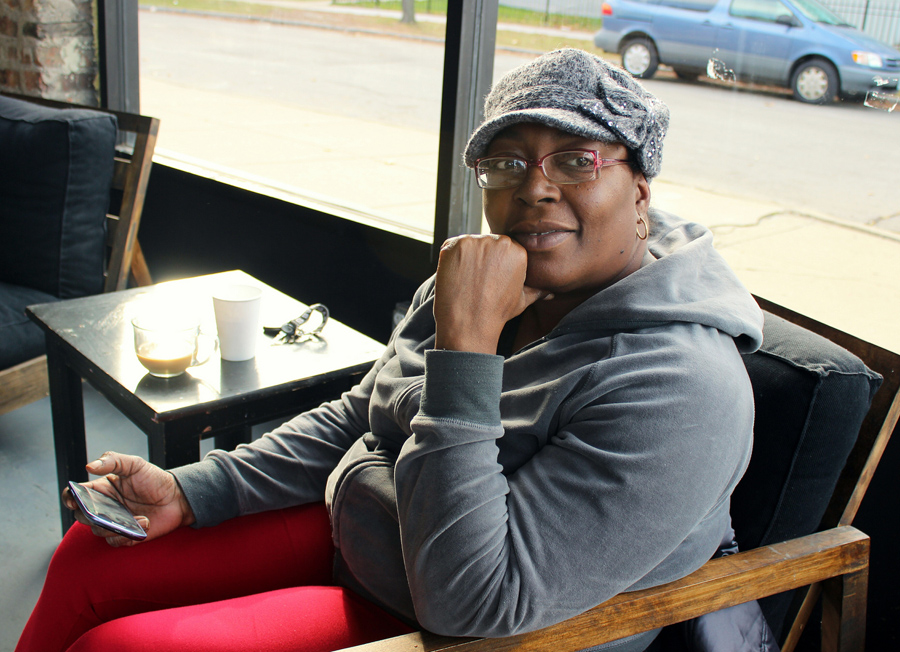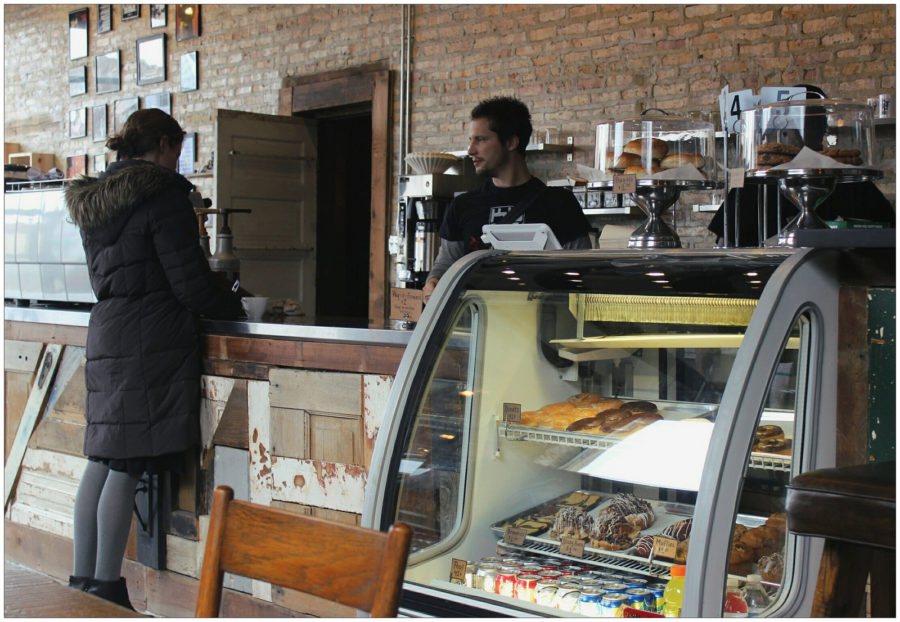A Coffee House for Englewood

Kusanya Café, an inline espresso bar and gallery located at 825 W. 69th Street, opened last month to a flurry of press intrigued that someone would launch such a business venture in Englewood. Writers described it as a “rare sit-down dining experience” in the neighborhood, and expressed curiosity about management’s decision to not install bulletproof glass.
Four years passed between the initial idea of opening Kusanya Cafe and its debut on November 19, 2013. Those years were fraught with multiple instances of absentee commercial property owners backing out of lease negotiations, and banks refusing to lend money for the venture. Kusanya’s eventual success relied heavily upon Kickstarter funding and the rallying of resources within the neighborhood.

On the surface, the launch of Kusanya Café revealed the story of everyday heroes who set a goal and achieved it; however, this same story also enlightened how difficult it is in our city for a troubled neighborhood to find the support it needs when residents seek to revitalize from within.

Englewood is widely perceived by Chicagoans as a dangerous, irredeemably blighted area that should be avoided at all cost. Many Chicagoans only know the neighborhood through news about crimes that have happened there, and by sensationalized stories that portray the area as an archetypal example of urban decay and violent corruption. Run a Google image search on Englewood, and the top results will consist mostly of photos of crime scenes and vacant, boarded up buildings alongside empty lots. Search on YouTube, and you will find similarly one-dimensional results. How did this happen?

In truth, most of Englewood’s problems can be traced to a long-term disinvestment in the community that began in the 1940s and persists to this day. As the Encyclopedia of Chicago recalls:
The 1940s witnessed a decline of real-estate values in Englewood. Buildings were 40 years old, and the expanding Black Belt population from the east resulted in rapid turnover. Materials necessary to redevelop Englewood were scarce owing to World War II, and later practices of redlining and disinvestment sealed Englewood’s future as a low-income community with a declining housing stock. In 1959, a Chicago Sun-Times writer interviewed a banker about lending in Englewood. His reply illuminates attitudes among lenders at the time. ‘When a lender makes a loan on a house, he looks at the total financial position of the borrower. The rate is determined by risk. The Negro has to pay a higher rate because he is not as secure in his job.’

The city has recently engaged in widespread demolition of the neighborhood’s historic housing and commercial properties. This trend has stripped away evidence of Englewood’s proud heritage and crippled the residents’ opportunities to build and nurture communal spaces.

The problem of neglected properties in Englewood has been greatly magnified by fallout from Chicago’s widely publicized 2008 bid to host the 2016 Olympics. In his recent interview with The Gate News, Kusanya executive director Phil Sipik spoke on this issue, “What we found is that a lot of people purchased buildings that don’t live in the neighborhood. They purchased properties with the hope of the Olympics coming to the South Side … they had no interest in truly developing the buildings. They just wanted to flip them.” As a result, much of that property purchased circa 2008 has been abandoned, and will most likely be left vacant in the foreseeable future. Its owners have no interest in repairing it so that residents or businesses can inhabit it.

What we see now in Englewood invites us to entertain questions of what can be done to revitalize a neighborhood that has a long history of being plagued by scarce financial resources and high crime statistics. Skeptics would follow the conventional wisdom that you must tear down in order to rebuild, and this necessarily means displacing the current community in order to build a new one. To me, this is a callous view that does not honor the ideal of a holistic and supportive urban environment. Is it time to see things differently?

The launch of Kusanya Café came about because a collective of residents had a goal and chose to empower themselves to achieve it. Their dream was not about tearing down what exists; rather, it was based in an idea of honoring and amplifying the positive energy that has been in their community all along. Their success can now serve as an inspirational blueprint for others who entertain goals aimed at revitalization of a community from within. The obstacles they faced can serve to freshly enlighten the deep roots of the chronic disinvestment that continues to devastate this community.

In his recent interview with The Gate News, Kusanya’s Phil Sipka spoke on what makes his neighborhood special:
It’s still super communal…People know each other and they know what’s going on. And they’re absolute heroes; they’re some of the most incredible people you’ve ever met in the entire world.
He believes many don’t realize the beautiful diversity that exists in the community, and he is committed to a mission of maintaining the café as a friendly local gathering place and a venue to empower and promote neighborhood artists.

Much of Kusanya Café’s décor is crafted from architectural salvage. Phil and the neighborhood collective saw potential in the discarded bits and pieces around them, and used them to create a fresh and inviting new public space. In a way, the décor could be viewed as symbolic of the inspiration behind Kusanya Cafe. When a neighborhood unites behind the good that is already within it, beautiful and revolutionary things become possible.
You can like Kusanya Cafe on Facebook or follow them on Twitter for current news about the venue.
Resources/Additional Info:
- Englewood (Encyclopedia of Chicago)
- Kusanya Cafe on Tumblr
- Kusanya Cafe Kickstarter project
- Making a home in Englewood (Chicago Weekly)
- Kusanya Cafe To Offer Rare Sit-Down Dining in Englewood (DNAinfo)
- Englewood resident collective brings new café to the neighborhood (The Gate News)


Love this story Stephanie! I look forward to checking out Kusanya Cafe.
boosh
Grew up on the westside went to Crane the only opening we had in recent memory was Felony Franks (and you know how that went down)here’s hoping you branch out here.